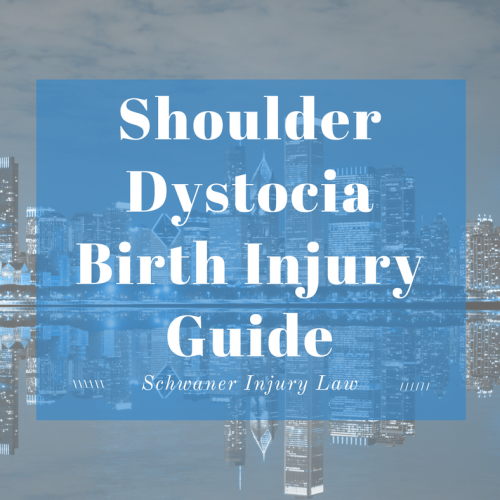
Shoulder Dystocia Birth Injury Guide – Birth Injury Information
In June of 2006, America Camacho suffered a shoulder dystocia birth injury when she was delivered at Norwegian American Hospital in Chicago.
The injury occurred due to what is known as fetal macrosomia, which meant that she was just too big to be safely delivered vaginally. The average cutoff is 8 pounds, 13 ounces. A baby weighing more than that is considered significantly larger than average, and poses risk not only for the fetus, but also for the mother. Shoulder dystocia is a common injury.
Baby America was estimated at weighing just under eight pounds, despite head and abdominal circumferences that showed up on ultrasounds, both suggesting that she was a larger-than-average baby. When she was born, America weighed 10.5 pounds, and suffered serious injuries to her right arm when it became lodged behind her mother’s pubic bone after her head was delivered using a vacuum extractor but the rest of her body failed to follow.
While America’s doctor was able to eventually extract the baby using certain maneuvers, America suffered serious injuries that resulted in millions of dollars in medical expenses.
Shoulder Dystocia: A Closer Look
Shoulder dystocia is relatively uncommon – it occurs is about 1 percent of all births – but because of a variety of factors, it can be one of the most terrifying emergencies in the delivery room because the condition is complicated by two factors:
- If the birth takes too long, the umbilical cord can become compressed, depriving the child of vital oxygen, leading to potentially serious birth defects or death.
- If the delivery is rushed, however, in an effort to avoid oxygen deprivation-related injuries, there is a big risk of damage to the brachial plexus nerves – the nerves that send signals from the brain to the arm, hand, and fingers – which can cause limited mobility and paralysis.
The complications associated with shoulder dystocia can impact both mother and child, and for mom, can include postpartum hemorrhage, rectovaginal fistulas that allow bowel excretion to leak into the vagina, dislocation of the pubic bones and uterine ruptures.
The infant usually suffers more serious injuries, including:
- Brachial plexus palsy, which can range from stretched or completely separated brachial plexus nerves, impacting arm, hand and finger movements as well as sensitivity. Brachial plexus injuries can either heal on their own or lead to lifelong paralysis of the arm because the severity levels are so varied.
- Fractures of the clavicle or humerus bone.
- Hypoxic injury, which occurs when oxygen is cut off from the brain due to compression of the umbilical cord, potentially leading to permanent neurological damage.
- Fetal death.
Which Moves Are Made When a Baby Suffers Shoulder Dystocia?
While no ideal treatment exists for shoulder dystocia, there are various steps that are recommended for a physician to take during delivery if there are signs of the condition. (The most obvious is if the baby’s head emerges from the birth canal, only to pop back in again like a turtle’s.)
In cases of shoulder dystocia, the mnemonic HELPERR offers protocol to be followed, and includes the following maneuvers:

- H for Help. Calling for help ensures that properly trained personnel are available with the appropriate equipment.
- E for Episiotomy. While an episiotomy is unlikely to relieve the shoulder dystocia, it can create more room if rotation maneuvers are required.
- L for Legs. The McRoberts maneuver involves positioning the mother’s legs so that her thighs are pressed against her abdomen, positioning the pelvis so it is more flexible, making it easier to manipulate the baby’s shoulders through the birth canal.
- P for Suprapubic pressure. Sometimes, applying pressure to the fetal shoulder from above in a manner similar to doing CPR helps propel the shoulder through the birth canal.
- E for Enter maneuvers. The doctor attempts to manipulate the fetus in such a way that the shoulder moves through the birth canal.
- R for Remove the posterior arm. By bringing the posterior arm from the birth canal, it allows the fetus to drop, making it easier to safely free the shoulder from the pelvis area.
- R for Roll the patient. If the mother rolls over and gets on all fours, the new position will often dislodge the baby’s shoulder. If not, gravity may also make maneuvering the baby through the birth canal easier.
What Should You Do If Your Baby Suffers Shoulder Dystocia?
If there are risk factors for shoulder dystocia, steps can be taken to ensure a safe, injury-free delivery.
Some common risk factors include:
- A mother that is shorter than average or has an abnormal or small pelvis.
- Gestational diabetes.
- Obesity.
- A pregnancy lasting beyond the projected delivery date.
- Previous instances of shoulder dystocia.
- An exceptionally large baby.
Unless the injury is the result of a long labor, if shoulder dystocia occurs, in most cases, it is often the result of a medical error, including the improper use of assisted birthing devices or the inability to properly anticipate shoulder dystocia based on risk factors.
Because medical error so often plays a role in shoulder dystocia, it’s important to contact an attorney with experience in birth injury medical malpractice cases to ensure that your baby is able to receive the care he or she needs.
Care could include physical and occupational therapy, surgery and other medical expenses, depending on the severity of your baby’s injuries.
“I would highly recommend Attorney David Schwaner”
![]()
“I would highly recommend Attorney David Schwaner and Schwaner Injury Law, to anyone. Not only is David knowledgeable and a gifted attorney, he’s a very sympathetic individual who takes the time to get to know you and your situation. He makes sure to answer all your questions, return all your calls, and always has your best interest at heart. Really top notch attorney, and law firm.”
Konrad T.











